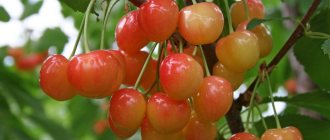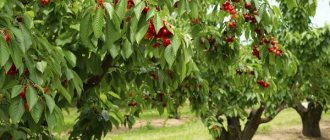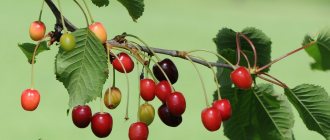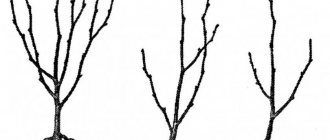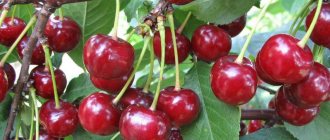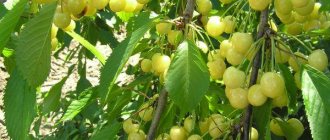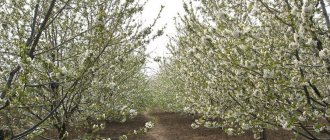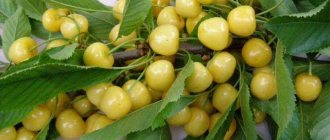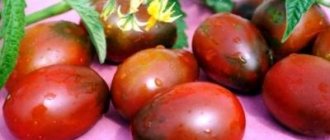Cherry Yantarnaya: description of the variety
The Yantarnaya variety of cherries was bred by specialists from the National Botanical Garden. N.N. Grishko NAS of Ukraine. The institution is engaged in the design of botanical gardens and the protection of natural resources. The varieties Gaucher black and Drogana yellow were used in the work.
Mature tree height
Cherry variety Yantarnaya is a tree of medium vigor, 3-4 m high. The crown is drooping, spreading, with medium foliage. The shoots are straight, bare, yellowish in color. The bark is smooth gray. The leaves are oval and dark green. Petioles are about 50 mm long.
Flowering and ripening period
Flowering begins in the mid-early period. The first buds form in the second half of May. Fruit ripening occurs in late June and early July. The berries are collected in bouquets and are easily separated from the stalk. According to the description and photo of the Amber cherry, its fruits are light yellow in color. Sometimes a pinkish blush appears on the skin. The berries are heart-shaped, weight ranges from 5.2-6.5 g. The pulp is tender, juicy, cream-colored. The stone is medium-sized and easily separated from the pulp. The taste is sweet, rated 4.4 out of 5.
Productivity
33-35 kg of fruits are collected from the tree. Productivity is stable. The first fruits ripen 4 years after the tree is planted in the ground. Cherries can hang on branches for a long time without falling off. Yellow fruits do not attract birds, so you don’t have to worry about the safety of your harvest.
Transportability
The fruits of the Yantarnaya variety do not tolerate long-term transportation. After harvesting, it is recommended to find a use for them as soon as possible. Cherries are consumed fresh or used for homemade preparations (jams, compote, jams).
Drought resistance
Yellow cherry Amber has average resistance to drought. In the absence of moisture, the ovaries fall off and the yield decreases. The tree is watered according to the standard pattern for this crop.
Frost resistance
The Yantarnaya variety tolerates temperature drops in winter down to -30 °C. To protect against frost, the tree is provided with additional shelter.
General information about culture
At the end of the last century, Ukrainian breeders set out to create a productive variety of cherries with large yellow fruits. To do this, they crossed the varieties Gaucher black and Drogana yellow. Work on developing a new variety was carried out at the Research Institute named after. Grishko. The date of creation of the variety is considered to be 2001. In Russia, breeders decided to improve this variety, zoning it for growth in different regions of our country. The result was a variety of Orlovskaya amber cherries, it was included in the State Register, and it was created at the Research Institute for the Breeding of Fruit Crops.
How to plant Amber cherries
Its further development and fruiting depend on the correct planting of the Yantarnaya variety. Healthy seedlings are purchased for planting. The place for growing the crop is chosen taking into account the lighting and soil quality.
How to choose a seedling
Seedlings of the Yantarnaya variety are purchased from nurseries or gardening centers. Before purchasing, the plant is visually assessed for the absence of traces of mold, rot and other defects. One- or two-year-old shoots with a healthy root system are suitable for planting. Also pay attention to the quality of the conductor. For planting, use cherries with one conductor. During transportation, the root system is wrapped in a damp cloth. If the roots of the tree are dry, they are immersed in clean water for 3 hours.
Planting dates and scheme
The timing of planting the Yantarnaya variety depends on the climatic conditions of the region. In the southern regions, work is carried out in the fall after leaf fall. Then the plant will have time to take root before the onset of cold weather. In regions with cool climates, planting is postponed to spring. After the snow melts, they wait for the soil to warm up. The work is carried out until the buds on the trees swell. Yantarnaya cherries are removed from apple, plum, pear and other trees at least 5 m. It is better to plant different varieties of cherries or cherries in a group. Leave 2-3 m between them.
Advice! For the culture, choose a well-lit area where moisture does not accumulate. Cherries prefer loamy or sandy loam soil.
Pit preparation
They begin to prepare the pit 2-3 weeks before planting the Yantarnaya cherry variety. During this time, the soil shrinks, which can damage the seedling. If the work is carried out in the spring, then it is better to prepare the hole in the fall. At the selected location, dig a pit measuring 60x60 cm and 70 cm deep. If the soil is heavy, a drainage layer 10 cm thick of expanded clay or crushed stone is placed at the bottom. Then they begin to prepare the soil. 10 kg of humus, 100 g of potassium sulfate and 200 g of superphosphate are added to the fertile soil. Part of the mixture is poured into the hole and left to shrink. When the soil settles, begin planting.
Landing Features
In order for the plant to take root well, before planting you need to familiarize yourself with some rules for growing Yantarnaya cherries.
Read also: How to grow good tomato seedlings - feeding, video
Recommended timing
Depending on climatic conditions, it is necessary to plant yellow Amber cherries at different times.
There are no cold winters in the south, but the summers are very hot, and if you plant a seedling in such conditions in the spring, you can ruin it. Conversely, Amber cherries planted in the spring in the middle zone will be able to get stronger by frost.
Choosing a suitable location
The place for Yantarnaya must be in a spacious sunny area. The soil should be loose, rich in trace elements and minerals. The presence of a pond is not recommended.
Leave 5 m between trees.
What crops can and cannot be planted nearby?
Due to the presence of the same diseases with Amber cherries, it is not recommended to plant together:
It is also impossible to place berries such as currants under the crown of plants of this variety. They will certainly die.
Selection and preparation of planting material
The soil for planting Amber cherries is prepared in advance.
- Mix 2 buckets of soil: 1 kg of wood ash and superphosphate.
- Add 3 buckets of humus, ammonium sulfate and potash fertilizers.
Landing algorithm
- The soil is dug up. Loose soil is important for Amber cherry.
- Dig a hole at least 90 cm in depth and 80 cm in width.
- The hole is filled with the prepared healthy mixture.
- Fix a peg in the middle.
- Amber cherry seedling is dug in and tied to a support.
- Cover with soil and water abundantly.
Caring for Amber cherries
The development and fruiting of a crop largely depends on care. The tree is provided with fertilizing, watering, and weeding. To form the crown, shoots are pruned.
Feeding and watering
Yantarnaya cherries are watered three times per season:
- during flowering;
- when fruits ripen;
- late autumn, before preparing for winter.
Be sure to take into account precipitation in the region. Up to 4 liters of water are poured under young trees. When the cherries begin to bear fruit, the water rate is increased to 15 liters. Irrigation requires warm, settled water. The tree is moistened in the morning or evening.
Fertilizing of the Yantarnaya variety is carried out according to the following scheme:
- before flowering, the tree is watered with a solution consisting of 20 g of superphosphate, potassium salt and urea;
- After harvesting, fertilizing is repeated, however, urea is excluded.
Complex mixtures developed for fruit crops are suitable for fertilizing plantings. Nitrogen fertilizers are applied only in the spring, as they promote shoot growth at the expense of yield.
Weeding and loosening
The soil in the tree trunk circle is regularly weeded to remove weeds. Loosening the soil improves the absorption of moisture and nutrients. It is recommended to cultivate the soil after watering and fertilizing. To reduce the amount of weeding, the soil in the tree trunk circle is mulched with peat or humus. Mulch is an additional source of nutrients for cherries that retains moisture in the soil.
Crown formation
By forming the crown, you can control the growth of cherries and get a high yield. Pruning is carried out in early spring, when sap flow has not yet begun, or in late autumn after leaf fall. Young plantings are pruned when they grow to 70 cm. Side shoots are shortened to 50 cm. If the branches grow at an acute angle to the trunk, they are completely cut out.
The crown is formed in the form of tiers consisting of skeletal shoots. The first tier consists of branches located at a distance of 10-20 cm from each other. 60 cm is left between the levels. The formation of the crown takes several years. When the tree reaches the age of 5-6 years, it is enough to maintain its height at 3 m. Be sure to remove damaged and improperly growing branches.
Pollinators of the Yantarnaya cherry
The Yantarnaya variety is self-sterile. To form ovaries, it is necessary to plant pollinators that bloom at the same time as the Yantarnaya variety. Species suitable for this purpose: Revna, Tyutchevka, Syubarovskaya, Severnaya, Ovstuzhenka. Amber cherry pollinators are placed in an area with a distance of 3-4 m. To attract insects, honey-bearing flowers are planted nearby.
Characteristics
The amber variety tolerates heavy rains and drought well, and the fruits do not crack. Due to the original color of the berries, cherries are protected from bird attacks, which leads to the preservation of the fruits on the plant.
Drought resistance, winter hardiness
The variety is characterized by such important qualities as resistance to frost and prolonged lack of watering. Thanks to the frost resistance of the Amber cherry, the variety will not die and will bear fruit stably even after frosts down to -30 °C.
It is recommended to water Amber once a month. After the dry season, the plant must recover, so watering is increased to once a week. Both standing water and running water are suitable.
The video will tell you about other features of yellow-fruited cherries:
Pollination, flowering period and ripening time
The Yantarnaya variety cannot pollinate on its own. Along with it, other plants are planted that will perform this function.
The following varieties are suitable as pollinators for Amber cherries:
- Knight;
- And the way;
- Northern;
- Ovstuzhenka.
Cherry ovaries appear after pollination and form within a month. They come with a pointed end and are shaped like a heart.
The ripening of fruits on the plant occurs quite quickly; the berries of this variety are located in bouquets on “legs” and are easily separated.
Productivity, fruiting
According to the description of the Oryol Amber cherry in various sources, it does not begin to bear fruit immediately. The plant takes about 4 years to become strong. During the harvest period, the variety usually produces 35 t/ha per year. This is considered average for commercial use. In private gardens, this amount of fruit is more than enough.
To get a rich annual harvest from cherries, you need to follow the rules of care.
Area of application of berries
Yantarnaya berries are mainly eaten unprocessed, enriching the body with vitamins and minerals. Cherries are good for maintaining health:
- serves as a prevention of various diseases;
- improves blood composition;
- normalizes digestion.
You can also cook compotes from cherry fruits, make preparations for the winter: preserves, jams, jellies, confitures - and add fresh or frozen berries to baked goods.
Thanks to its beneficial properties, cherries have also found application in cosmetology. Masks made from the juice and pulp of Amber berries slow down aging and improve skin quality.
Resistance to diseases and pests
Oryol amber cherry is resistant to rust and coccomycosis. However, some diseases can damage the crown and lead to complete death of the variety.
The plant may be affected by cylindrosporiosis infection. The disease is of fungal origin. Infection occurs through the wind. All above-ground parts of this cherry variety are affected. The disease manifests itself as spots on the leaves, in the place of which holes subsequently form.
The most common insect that interferes with the growth of Amber is the cherry fly.
To prevent it from laying its larvae, for preventive purposes, Amber cherries are sprayed twice according to a certain pattern:
- When the air warms up to 18 ºC and the flies just appear.
- in 10–15 days.
How to properly feed strawberries with chicken droppings and methods for preparing fertilizers
Other cherry pests:
- weevils;
- butterflies;
- aphid;
- sawflies.
They slow down growth and damage the bark and shoots.
Advantages and disadvantages
The plant has many benefits. The attractive characteristics of the Yantarnaya cherry variety include:
- frost resistance;
- regular fruiting;
- immunity to coccomycosis;
- resistance to fruit cracking;
- protection of the plant from sparrows and tits;
- exclusion of gray rot infection;
- ease of care;
- earlier maturation.
However, the Orlovskaya Yantarnaya cherry variety also has weaknesses.
Disadvantages of this type:
- requires pollination by neighboring plants;
- yield value is within the average;
- not suitable for areas with harsh winters.
Diseases and pests of Amber cherry
The Yantarnaya variety is resistant to the main cherry diseases - coccomycosis and monilial blight. These diseases are fungal in nature and develop in high humidity. Parasite spores enter the area along with low-quality seedlings and pests.
Important! To protect plantings from diseases, preventive spraying is carried out, and shoots are regularly pruned.
Dangerous crop pests include aphids, cherry flies and moths, pipeweeds, and moths. Insects feed on the juice of leaves or fruits and slow down the development of cherries, which leads to a decrease in yield. The insecticides Karbofos, Karate, Fury or folk remedies are used against them. To prevent the spread of diseases and pests on the site, the following agricultural practices are followed:
- remove and burn fallen leaves;
- in the fall they dig up the soil in the tree trunk circle;
- regularly weed the soil to remove weeds;
- they clean the bark of moss and lichen, and whitewash the trees.
Cherry processing Amber
Regular treatments of the Yantarnaya variety will help avoid the development of diseases and the spread of pests. Prevention begins in early spring before sap flow begins. Add 70 g of urea to 10 liters of water. The resulting solution is sprayed onto trees. It is important to avoid contact of the liquid with the kidneys, since urea causes a burn.
Attention! Folk remedies are used for preventive purposes. To process cherries, infusions are prepared from wood ash, tobacco dust, onion and garlic peels.
To protect the Yantarnaya variety from diseases, it is sprayed with a solution of the fungicide Karbofos, Antilin or Nitrafen. Treatments with Fitoverm, Iskra-bio, and Agravertin are effective against pests. To increase the resistance of the variety to unfavorable conditions, spraying with Zircon is practiced. In the autumn, after leaf fall, the cherry processing is repeated. It is important to irrigate if the trees have been exposed to diseases or pest attacks.
Preparing Amber cherries for winter
Mature cherries are able to withstand winters without shelter. To help the tree survive the cold, winter watering is performed. 8-10 liters of water are poured into the tree trunk circle. Moisturizing will protect the root system from freezing.
Additionally, they spud the trunk. The tree trunk circle is mulched with humus 10 cm thick. To prevent the cherry tree conductor from being damaged by hares and mice, it is wrapped in mesh or roofing felt. Young plantings are covered with burlap or agrofibre. The top of the planting is covered with spruce branches. In winter, an additional snowdrift is placed on the cherry tree. There is an additional description of cherries in the video below.
